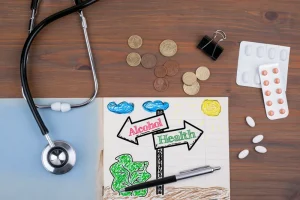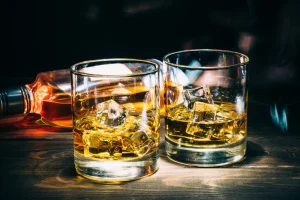
Alcohol hypoglycemia has been reproduced by sustained (8-h) administration of ethanol, with blood levels up to 97 mmol/l (19). The effect is more potent after 2–3 days of fasting and potentially lethal in patients with chronic alcoholism who are treated with insulin (20). However, in circumstances in which gluconeogenesis is not critical to maintaining blood glucose, its suppression by ethanol seems less likely to cause hypoglycemia. In the patients in our study, there was certainly no immediate decrease in glucose after consumption of wine, and we would have to postulate reduced basal glucose output persisting 2–4 h beyond elimination of ethanol if this were the sole mechanism. Moreover, ghrelin may decline endogenous glucose production, through supression of insulin secretory capacity [34], while reinforcing insulin action on the glucose disposal [35].
Impairment of Other Metabolic Processes
Dose-response relationship between average daily alcohol consumption and incident type 2 diabetes, stratified by sex. Finally, factors potentially contributing to any observed heterogeneity were investigated. These were thought to include participant age, method of case ascertainment, degree and type of confounder adjustment, follow-up duration, the healthy worker effect (32), and population region (33). Due to the risk of aggregation bias, only a subset of factors could be explored in the absence of individual-level data (34). Data were stratified on each appropriate factor, with differences explored visually after adjustment for the effect of sex and reference group. 1The prefix “hyper-” always indicates higher than normal levels of a substance, whereas the prefix “hypo-” indicates lower than normal levels.
The Immediate Effect of Alcohol in People With Diabetes
This potentially beneficial effect was observed in both men and women, regardless of age. The alcohol amounts administered in those studies were usually between 0.5 g/kg (gram per kilogram body weight) and 1 g/kg, leading to blood alcohol levels (BALs) between approximately 0.03 and 0.1 percent2 (McDonald 1980). Those doses are equivalent to approximately 2.5 to 5 standard drinks.3 Interestingly, studies of acute alcohol exposure in nondiabetic people have yielded quite variable results, noting decreases, increases, or no changes in glucose levels. For patients with abnormal glucose metabolism, occasional drinking (less than once a week) reduces the risk of all‐cause mortality, while heavy alcohol consumption (≥30 g/day for men and ≥15 g/day for women) significantly increases the risk of new‐onset stroke. They should avoid heavy alcohol intake, but light alcohol consumption or occasional drinking is acceptable.
Genetic Variation in ADH and ALDH
Most people benefit from consuming a snack or meal that contains some complex carbohydrates, protein, and fat. For example, if you have a glass of alcohol with dinner, choose roasted chicken, baked sweet potato, and sautéed spinach. Ideal physical activities were defined as ≥150 min/week at moderate intensity, ≥75 min/week at vigorous intensity, or ≥150 min/week at moderate and vigorous intensity.19 All forms of walking were considered, including walking during work and spare time that lasted at least 10 min.
Thus, a person who has been drinking alcohol and not eating for 1 or more days has exhausted his or her glycogen supply. Insulin resistance does not immediately lead to overt diabetes, because the patient’s pancreatic beta cells initially can increase their insulin production enough to compensate for the insulin resistance. In fact, insulin-resistant people have higher than normal insulin levels (i.e., are hyperinsulinemic1). In time (i.e., probably after several years), however, the pancreas cannot keep up with the increased demand for insulin; although insulin production still may be higher than in nondiabetic people, it is no longer sufficient to overcome insulin resistance. Ultimately, insulin secretion declines even further, to levels below those seen in nondiabetics (although generally still higher than those seen in type 1 diabetics).
- Thus, brain is one of the most vulnerable organs from alcohol-induced toxicity.
- Some people who take oral diabetes medicines should talk with their provider to see if it is safe to drink alcohol.
- Be sure to eat a meal or snack containing carbohydrates if you are going to drink alcohol.
- However, in the current study, hypertension and dyslipidemia were not included as covariates.
The enzymes alcohol dehydrogenase (ADH), cytochrome P450 2E1 (CYP2E1), and catalase all contribute to oxidative metabolism of alcohol. ADH, present in the fluid of the cell (i.e., cytosol), converts alcohol (i.e., ethanol) to acetaldehyde. This reaction can diabetics get drunk involves an intermediate carrier of electrons, +nicotinamide adenine dinucleotide (NAD), which is reduced by two electrons to form NADH. Catalase, located in cell bodies called peroxisomes, requires hydrogen peroxide (H2O2) to oxidize alcohol.

The mechanisms underlying the development of alcoholic ketoacidosis are complex. However, some typical contributing factors result in insulin lack and excess glucagon levels, thereby promoting the development of ketoacidosis. As mentioned earlier in this article, poor food intake can lead to depleted glycogen levels. Furthermore, continued alcohol metabolism results in diminished gluconeogenesis.


It appears that neither acute alcohol intoxication nor chronic alcohol feeding consistently alters basal glucose uptake by skin, intestine, spleen, lung, kidney or whole liver [12,14,73]. Further, alcohol did not alter in vivo glucose uptake by hepatocytes, Kupffer cells or hepatic endothelial cells [74]. These findings are divergent to that observed in other catabolic conditions where glucose uptake is enhanced in macrophage-rich tissues [75]. In vivo determination of transhepatic glucose flux in 48–72 h fasted dogs, with essentially no glycogen reserves, indicates acute alcohol markedly impairs gluconeogenesis [31]. Alcohol also dose-dependently inhibits lactate-stimulated gluconeogenesis when given acutely in the in situ perfused liver [32] and when added to isolated hepatocytes [33].

Participants
In most patients, the disease develops before age 40, primarily during childhood or adolescence. In those patients, the immune system attacks certain cells of the pancreas, called beta cells. (For more information on the structure and function of the pancreas, see textbox, p. 213.) Beta cells produce insulin, one of the two major hormones involved in regulating the body’s blood sugar levels and other metabolic functions.

Alcohol and Basal Glucose Homeostasis
- In the absence of insulin, the triglycerides are broken down into free fatty acids, which are secreted into the bloodstream and delivered to the liver.
- For example, GLUT4 protein in the plasma membrane fraction of the gastrocnemius, but not in whole muscle homogenate, was reduced in alcohol consuming rats [14,57].
- The authors speculated that the mechanism for the increase in insulin secretion might have been an ethanol‐induced increase in glucose absorption from the gut15 or an increase in gastrointestinal secretagogue secretion3.
- In particular, ethyl-α-D-glucoside, which is present in sake, has been found to prevent product of interleukin 6 and liver injury49.
The degree of agreement between reviewers was determined using the Cohen and Fleiss κ (21) statistics. When it comes to alcohol and diabetes, two related factors come into play — how diabetes medications and alcohol coexist in your system and the effect that drinking has on your liver. That’s why it’s best to talk with your healthcare provider about drinking alcohol when you have diabetes and how (or whether) you can do it safely.
